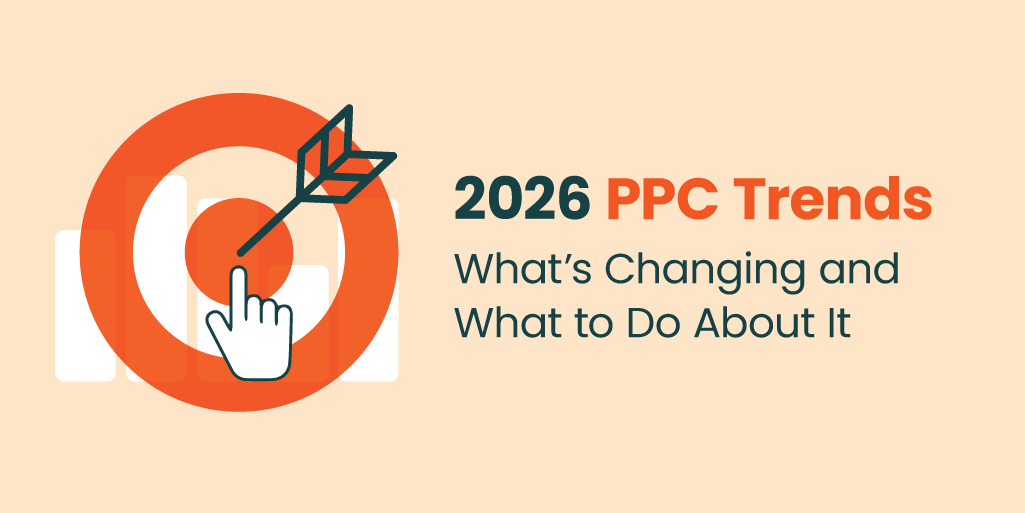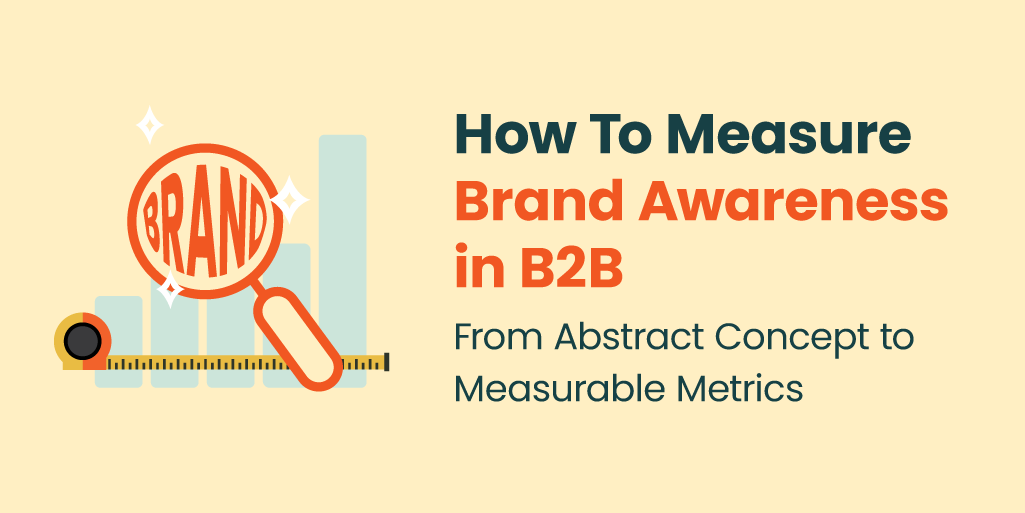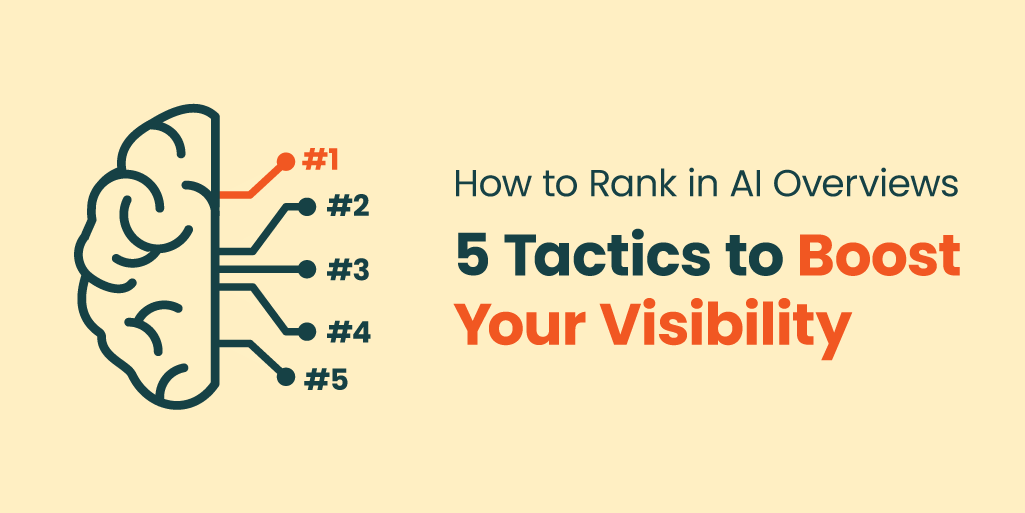It’s been two years since ChatGPT became open to the public, and one year since Google’s AI Overviews upended Search as we knew it. Next year is shaping up to be the moment when the rubber truly meets the road for PPC with creative direction, targeting, data management, and fraud prevention all needing to adapt to the new reality.
Make no mistake: while the critical levers we’ve relied on (keywords, match types, bid strategies) will be a little harder to pull, new tactics and opportunities are emerging.
Below is your field guide to the most important 2026 PPC trends that will affect your paid strategy, capabilities, and ultimately, your cost per conversion. We are breaking out the crystal ball to provide you with some predictions — including what exactly will happen, why it matters, and how to adapt without losing performance (or your sanity).
1. Signal-Led Targeting and Account-Based Advertising
What’s happening:
B2B marketers are delineating between awareness spend and lead generation, the latter of which is shifting toward signal-led strategies that identify and activate real buying intent. The rise of tools like Leadfeeder and RB2B means you can now see which companies are visiting your site, even before they fill out a form. Combine that with enrichment layers from platforms like Clay, and you can segment by firmographic and behavioral data to target only the accounts that matter.
This approach blends first-party intent data (your site traffic) with ad activation, forming a tighter loop between who’s researching and who you advertise to. It’s a modern evolution of Account-Based Advertising (ABA), where ad dollars go toward warming engaged accounts — not broadcasting to the entire market, which is reserved for brand awareness advertising.
What it means:
- Ad efficiency rises, but so does complexity: The emphasis moves from audience reach to audience precision. Marketing and sales alignment becomes essential: both teams need to define what counts as a meaningful signal and ensure that engagement data feeds directly into ppc campaigns.
- Personalization also scales differently: less about ad creative for the masses, more about thematic resonance for segmented account clusters (e.g., companies showing interest in “data security” or “AI infrastructure”).
What to do:
- Instrument your intent: Implement traffic de-anonymization and enrichment tools. Build logic that automatically tags visiting companies with attributes like industry, revenue, or technology stack.
- Segment dynamically: Use these enriched signals to create campaign cohorts. For example, companies researching “SaaS security” might receive targeted ads and landing pages built around risk assessment narratives.
- Shift budget to engaged audiences: Treat signal-led advertising as a mid-funnel accelerator, not a top-of-funnel play. Balance your media mix by reserving awareness spend for brand storytelling, and your ABA spend for accelerating active demand.
- Close the loop: Integrate CRM and ad data to track progression from site visit → ad exposure → opportunity. The power of signal-led targeting lies in proving that your spend is reaching the right companies and moving them toward deals.
2. Separate Brand Awareness Campaigns from Lead Generation: Trust Before Action
What’s happening:
Many B2B marketers are over-indexed on lead generation while under-investing in brand awareness, as best practice guidance suggests a 60/40 split (60% brand, 40% performance/lead gen) is ideal for growth (Report: Media in Focus, Les Binet and Peter Field). Yet buyers rarely raise their hand the first time they hear about you. Research consistently shows that multiple touches are required before a prospect even adds you to their consideration set.
The rise of signal-led targeting (traffic de-anonymizers, enrichment, and ABA) doesn’t replace awareness — it complements it. Brand campaigns are the stage-setters: they build familiarity, credibility, and authority so that when prospects show intent, they’re primed to respond to lead gen offers like ebooks, demos, or webinars.
What it means:
- Stand out in a crowded room: You can (and should) be creative, memorable, and “sticky” in your brand campaigns. This is your chance to tell bigger stories, use richer visuals, or experiment with humor and narrative — something that might feel too broad or risky for direct lead campaigns.
- Metrics and KPIs for brand awareness differ from lead-gen campaigns:
-
-
- Reach and impressions
- Share of voice/category presence
- Brand recall or recognition lift
- Engagement with creative (video completions, ad interactions)
- Search lift/direct traffic growth
-
- The pitfall of proving ROI: Lead gen KPIs like MQLs, form fills, and CPA are important, but not for brand awareness. Don’t get hung up on proving ROI upfront, it’s often impossible in the early stages. The payoff comes later, when brand familiarity accelerates conversion for ABA and other signal-led campaigns.
What to do:
- Separate campaigns, separate budgets: Allocate a portion of your media spend to awareness campaigns that live independently of your lead-gen programs.
- Experiment and be memorable: Use bold creative, storytelling, and formats that stand out to build trust and authority.
- Integrate with signal-led ABA: When accounts start showing engagement signals, activate lead-gen campaigns that are more tactical — ebooks, whitepapers, and demos — to convert interest into measurable opportunities.
- Measure appropriately: Focus on brand-specific KPIs, not immediate lead outcomes. Over time, awareness becomes the engine that makes your signal-led targeting more effective and your lead-gen spend more efficient.
Boost your 2026 PPC strategy—learn how brand awareness metrics sharpen campaigns and ROI.
3. All in on Automation, Google’s Push for Less Advertiser Control
What’s happening:
Google continues consolidating ad inventory and auction logic under “AI-first” campaign types like Performance Max and AI Max. Shopping, Video, Display, and Search are increasingly bundled, with asset groups and automation becoming the default. Most importantly, if you want to be eligible for AI Overview ads, you’ll need to be opted into at least one of the “Max” products or be using Broad Match keywords.
What it means:
- Less granular control, more system-level performance. Keywords continue to lose importance as match type criteria become more and more broad in Paid Search. Audience signals and off-platform conversion data are becoming essential.
- Creative quality and diversity will be vital. With budget and bidding mostly automated, the differentiator will be the richness and variety of inputs you feed the model.
- Measurement shifts from ad-level to portfolio-level. While Performance Max gained some insights in 2025, other products like traditional Search lost ground with increasing amounts of traffic going to unlisted “Other search terms.”
What to do:
- Architect your signals: Ensure your tracking is airtight. Pushing offline conversion events like qualified leads and closed deals is the only way to confirm your leads are genuine. Feeding those validated signals back into the platform can significantly boost performance.
- Overbuild creative: Develop deep asset libraries with headlines, long-form copy, images, short videos, and product feeds. Rotate quarterly. Test narrative themes, not just single ads.
- Establish guardrails: Clearly define your audiences and double down on audience and keyword exclusions. Structure campaigns around audiences rather than keywords so bad traffic can be identified and isolated quickly.
4. More Obfuscated Data (and How to Still See Clearly)
What’s happening
Privacy changes, modeled conversions, consent requirements, and platform “black boxes” mean fewer transparent levers and less deterministic reporting. Search terms reports are shrinking, placement transparency is tightening, and more conversion paths are modeled with cross-channel duplicates quietly de-duped away.
What it means:
- Attribution arguments intensify. Channel owners will each claim a bigger piece of the pie as models lean on probability.
- Benchmark volatility. Year-over-year comparisons are getting noisier as modeling techniques evolve.
- Qualified Leads, Calls, and Sales are your truth. Ad Platform numbers are becoming leading indicators while qualified conversions move through the pipe.
What to do:
- Own the measurement layer:
- Run Media Mix Models to quantify platform contributions.
- Test Brand Lift whenever possible to assess the value of hard to measure awareness tactics.
- Engineer “observable signals.” Track intermediate outcomes (e.g., scroll depth, quiz completions, sample requests) that predict revenue. Feed these back as value-based conversions.
- Reforecast norms. Move from strict YoY to rolling 90- or 180-day baselines, and publish variance bands for stakeholders.
5. More Advanced Ad Fraud (Bots, Spoofing, and AI-Generated Clicks)
What’s happening:
As budgets flow into automated, cross-network inventory, fraudsters follow. Expect smarter bots mimicking human behavior, inventory spoofing on the open web, and AI-driven click farms that outpace basic filters.
What it means:
- Defense fund. A portion of spend must always go toward verification, exclusions, and placement audits.
- Signal contamination. Fraudulent traffic can corrupt smart bidding if not quarantined quickly.
- Brand safety as a performance lever. Clean traffic improves model learning and ROAS.
What to do:
- Defense in depth:
- Use multiple verification layers (invalid traffic detection, viewability, post-click behavior checks). Products like Clickcease can provide turnkey solutions to help combat fraud.
- Maintain dynamic exclusion lists by domain, app, and placement; refresh weekly.
- Implement velocity rules (per-IP/session caps) via your preferred fraud prevention tool.
- Quarantine logic: Route suspicious cohorts to observation-only audiences. Suppress from value-based bidding until validated.
- Run lift tests on“blocked vs. allowed” inventory to quantify savings and justify your fraud defense investment.

Clickcease Dashboard
6. Lower ROIs on Paid Search (and Why That’s Not the End of the World)
What’s happening:
CPCs remain elevated as competitive pressures increase. Shopping products blend with search, branded queries are cannibalized into category terms, and AI-generated summaries continue to reduce overall click volume due to zero-click behavior.
What it means:
- ROAS down, acquisition costs up. The same advertisers are fighting for fewer clicks.
- Upper/mid-funnel carries more load. Retargetable audiences are increasingly created off-search, demanding stronger awareness tactics.
- Search becomes a closing channel. Informational queries are subsumed by AI Overviews; only high-intent users are clicking through.
What to do:
- Reframe KPIs by funnel:
- Treat Search as a conversion amplifier, not your sole acquisition engine.
- Shift from ROAS-only to profit/LTV or marginal CPA frameworks.
- Tap Into Awareness to Gather Intent :
- Build “problem-framing” content and capture forms that create first-party audiences you can feed into demand gen.
- Rebalance your channel mix and invest more where conversations start, not just where they end.
- Brand defense with nuance:
- Keep branded search live, but cap bids and reevaluate SOV targets. Your brand term may now function as a category term in Google’s eyes.
7. Improved Targeting (Yes, Even With Less Raw Data)
What’s happening:
Paradoxically, modeling is getting better. With larger cross-surface inventories and richer on-platform signals, systems can infer high-propensity audiences without exposing user-level data. These AI solutions can manifest themselves as advanced lookalike audiences, like LinkedIn’s Predictive Audience which will leverage your first- and third-party data to reach more users while maintaining relevancy. Despite being billed as an automated solution for beginners; proper setup, data fidelity, and tracking are crucial. When done correctly, they can dramatically help scale a campaign. When done incorrectly, however, they will quickly waste your budget.
What it means:
- Audience signals > audience lists. Context, creative themes, and conversion feedback shape targeting (See number one above for more on this).
- Less manual segmentation, more outcome design. You specify the result; the system finds the right people to deliver it.
What to do:
- Signal architecture:
- Build 3–5 Audience Targets per objective (e.g., “Value Seekers,” “Urgent Need,” “Research Mode,” “Luxury Upgraders”).
- Map creatives, offers, and landing pages to each profile.
- Value-based bidding: Feed back sales and lead data with tiered conversion values (AOV, margin, LTV likelihood). Let the system prioritize quality, not just quantity.
8. Greater Storytelling and Ad Customization: The New Performance Craft
What’s happening:
With automation handling mechanical tasks, the most competitive edge now lies in story quality and message-to-market fit. Brands that win aren’t producing more content — they’re producing smarter, more resonant narratives. Dynamic creative pipelines and generative tools make it possible to tailor stories by persona, industry, lifecycle stage, or even mood, at scale. This allows marketers to deliver messages that feel uniquely relevant to each audience while maintaining brand coherence. Automation doesn’t replace creativity; it amplifies it, freeing teams to focus on insight, emotion, and authenticity. The result is storytelling that connects more deeply and converts more effectively.
What it means:
- Your assets become your advantage. Brands with richer, modular narratives (headlines, proof points, visuals) win more auctions at equal bids.
- Landing experiences matter more. Models monitor post-click behavior; compelling stories drive engagement and positive signals. Remember, clicks will be fewer, but far more valuable.
What to do:
- Strategic storytelling over one-offs:
- Build a message matrix: audience, pain point, solution, proof (case study/stat), and CTA.
- Produce snackable variations (6–15 second video cuts, UGC-style content, product-in-use clips, testimonials) for every major media type.
- Programmatic personalization:
- Use ad customizers and feed-based text to inject industry, SKU, price, inventory, and regional proof points.
- Mirror the ad message on landing pages, reinforce credibility, and keep content easily digestible.
- Creative QA loops:
- Conduct monthly creative post-mortems: Which narratives drove higher assisted conversions or better view-through lift?
9. Potential New Partners to Watch
What’s happening:
As major AI platforms wrestle with monetization, new ad opportunities are on the horizon. ChatGPT may be first, with recent hires suggesting their 800+ million weekly users could soon be seeing ads.
What it means:
Prepared advertisers will have the advantage. While we can’t yet predict how advertising will function within AI platforms, it’s safe to assume the fundamentals will echo existing models. Those marketers with robust creative libraries, strong measurement, and compelling offers will be best positioned to win early.
Putting It All Together: Your 2026 PPC Operating System
- Measurement Backbone
Server-side tagging, standardized conversion taxonomy, centralized data warehouse, MMM, and periodic lift tests. - Signal-Rich Activation
Value-based conversions, audience signal profiles, clean exclusions, and multi-layered fraud defense. - Narrative Engine
A living message matrix, modular creative, feed-powered customization, and consistent creative-learning rituals. - Channel Sequencing
Video and social to create demand → Custom Audiences to harness intent → Search to confirm and close → Remarketing to extract LTV. - Governance & Guardrails
Budget bands, brand safety lists, rigorous campaign structures, and documentation of model changes and test outcomes.
Conclusion: 2026 PPC Trends and Beyond
The changes coming in paid media aren’t one of revolution but acceleration with the culmination of trends we’ve been tracking for nearly a decade. What were once “algorithmic models” and “machine learning” are now simply AI.
While adoption of these tools is no longer optional, the fundamentals of great marketing remain the same: compelling messaging, well-defined audiences, rich landing experiences, and strong attribution. The tools may evolve, but the craft endures.
If you’d like to learn more about how your brand can best position itself for this future, let’s talk. With decades of real world experience, Firebrand’s team has helped small and large brands stay ahead of the trends and outpace their peers. Recognized as B2B experts in the PPC space, we have helped new clients establish their nascent programs, while transforming legacy programs to be more efficient and nimble by utilizing advanced ABM approaches.
About the Author
Patrick Brady is the Director of Paid Media at Firebrand. With over 15 years of experience he helps lead digital clients through the ever changing world of online advertising. Prior to Firebrand, he led PPC efforts for multiple Fortune 500 companies across the B2B and B2C space.





